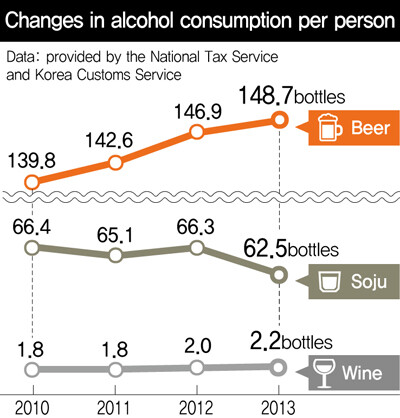hankyoreh
Links to other country sites 다른 나라 사이트 링크
New Brews: Beer still Korea’s favorite alcohol, but tastes are changing

Beer is South Koreans’ favorite alcoholic beverage, with top ratings for deliveries, market share, and preference, a survey shows.
As tastes diversify, beer imports have also risen nearly 300% between 2009 and 2014.
A report on alcoholic beverages from a 2015 survey of market conditions for processed foods published by the Ministry of Agriculture, Food, and Rural Affairs on Dec. 27 noted a 5.1% increase in beer deliveries from 1,962,000 ㎘ in 2009 to 2,062,000 ㎘ in 2013. Deliveries for diluted soju, another popular beverage, dropped 2.5% from 929,000 ㎘ to 905,000 ㎘ over the same period.
Beer also enjoyed healthy growth in imports and exports. Imports for 2014 totaled 119,501 tons and US$111.69 million , an increase of 288% and 301% respectively from the 41,492 tons and US$37.16 million recorded in 2009.

One reason for the sharp jump in beer imports is the introduction of different European and US beers at low prices since the establishment of free trade agreements (FTAs). Another factor has to do with shifting tastes, as more and more consumers turn from the plain lager flavor of domestic brews to the richer variety of imported lagers, ales, and wheat beers.
Lagers represent a more modern form of beer fermented at relatively low temperatures. They have a clear golden color and are easily stored. Ales, in contrast, are a more traditional variety fermented at higher temperatures with a dark color and richer flavor and scent. While lagers traditionally dominated the South Korean market in the past, the growing popularity of European ales has prompted domestic producers to make their own, including Sevenbrau, Queen’s Ale by Hite, and Aleston by OB. New traditional lagers with richer flavors and scents than past varieties have also emerged, including Lotte’s Kloud.
Beer has also gained a growing share of the domestic retail market. In 2014, beer accounted for 2.76 trillion won (US$2.4 billion) of the country’s total alcoholic beverage market of 5.278 trillion won (US$4.5 billion), or 52.3%. Next in line was soju at 28.1%, with traditional liquors coming in third at 5.7%.
Meanwhile, average yearly per capita consumption of beer rose from 139.8 in 2010 to 148.7 in 2013, a difference of 8.9 bottles. In contrast, consumption of soju dropped by 3.9 bottles from 66.4 to 62.5 and traditional liquor by 0.7 bottles from 33.7 to 33.
At 48.8%, beer ranked as the most preferred alcoholic beverage among South Koreans. In gender terms, males ranked soju first at 46.4%, while women preferred beer at 52.8%. Domestic beer accounted for 61.0% of consumption, compared to 21.6% for imports. Domestic consumption was higher among older people, while imports were more popular among younger drinkers.
By Kim Kyu-won, staff reporter
Please direct questions or comments to [english@hani.co.kr]

Editorial・opinion
![[Column] Has Korea, too, crossed the Rubicon on China? [Column] Has Korea, too, crossed the Rubicon on China?](https://flexible.img.hani.co.kr/flexible/normal/500/300/imgdb/original/2024/0419/9317135153409185.jpg) [Column] Has Korea, too, crossed the Rubicon on China?
[Column] Has Korea, too, crossed the Rubicon on China?![[Correspondent’s column] In Japan’s alliance with US, echoes of its past alliances with UK [Correspondent’s column] In Japan’s alliance with US, echoes of its past alliances with UK](https://flexible.img.hani.co.kr/flexible/normal/500/300/imgdb/original/2024/0419/2317135166563519.jpg) [Correspondent’s column] In Japan’s alliance with US, echoes of its past alliances with UK
[Correspondent’s column] In Japan’s alliance with US, echoes of its past alliances with UK- [Editorial] Does Yoon think the Korean public is wrong?
- [Editorial] As it bolsters its alliance with US, Japan must be accountable for past
- [Guest essay] Amending the Constitution is Yoon’s key to leaving office in public’s good graces
- [Editorial] 10 years on, lessons of Sewol tragedy must never be forgotten
- [Column] A death blow to Korea’s prosecutor politics
- [Correspondent’s column] The US and the end of Japanese pacifism
- [Guest essay] How Korea turned its trainee doctors into monsters
- [Guest essay] As someone who helped forge Seoul-Moscow ties, their status today troubles me
Most viewed articles
- 1[Column] The clock is ticking for Korea’s first lady
- 2Hong Se-hwa, voice for tolerance whose memoir of exile touched a chord, dies at 76
- 3After 2 months of delayed, denied medical care, Koreans worry worst may be yet to come
- 4[Column] Has Korea, too, crossed the Rubicon on China?
- 5US overtakes China as Korea’s top export market, prompting trade sanction jitters
- 6Samsung barricades office as unionized workers strike for better conditions
- 7All eyes on Xiaomi after it pulls off EV that Apple couldn’t
- 8[Correspondent’s column] In Japan’s alliance with US, echoes of its past alliances with UK
- 975% of younger S. Koreans want to leave country
- 10[Correspondent’s column] The US and the end of Japanese pacifism